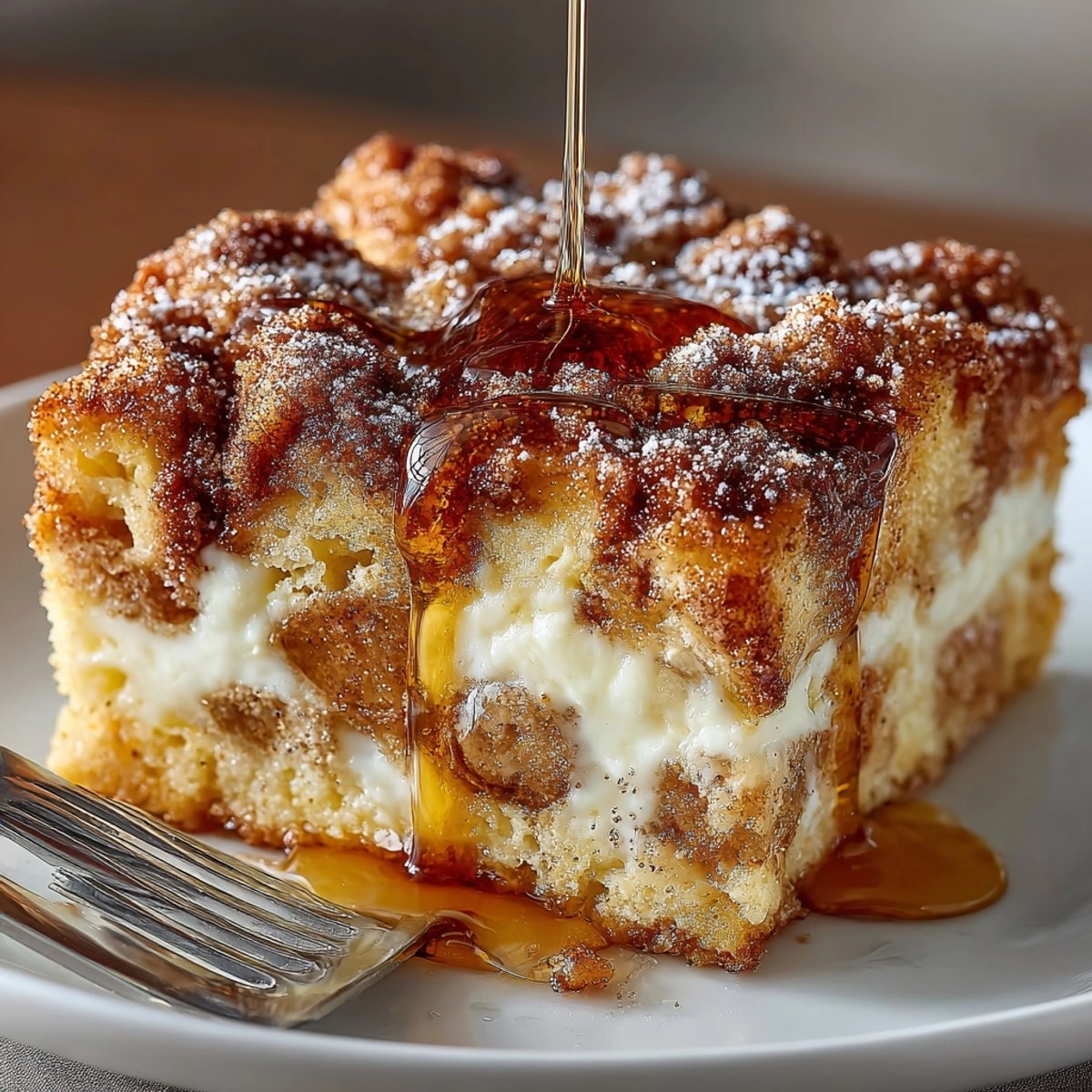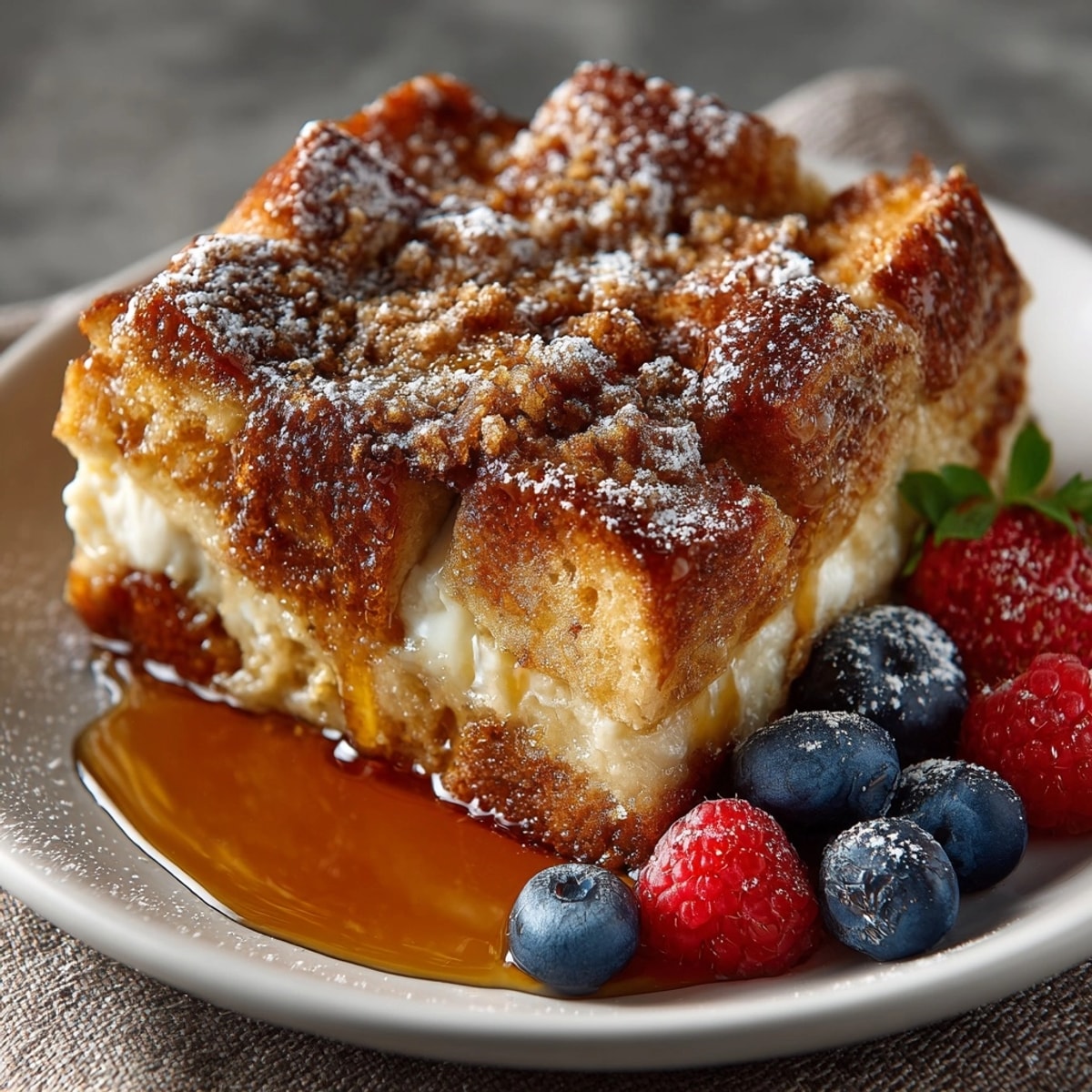 Save
Save This overnight French toast casserole transforms ordinary bread into a decadent morning treat that tastes like you spent hours in the kitchen. The magic happens while you sleep as the bread soaks up a rich custard, creating that perfect balance of crispy top and soft, pudding-like interior that makes breakfast feel special.
I first made this casserole when my in-laws surprised us with an overnight visit. The next morning, everyone thought I'd been up since dawn preparing breakfast, but I simply popped it in the oven while making coffee. Now it's our Christmas morning tradition, and the house fills with cinnamon aromas while we open gifts.
Ingredients
- French bread or brioche: Slightly stale bread works best as it absorbs the custard without becoming soggy. Day-old bread is perfect.
- Large eggs: The backbone of our custard mixture. Farm-fresh eggs with bright yellow yolks will give your casserole a richer color.
- Whole milk and heavy cream: This combination creates the perfect custard consistency. The fat content is important for that luxurious mouthfeel.
- Granulated sugar: Sweetens the custard without overwhelming. Look for pure cane sugar for best results.
- Vanilla extract: Use pure vanilla extract rather than imitation for a more authentic flavor.
- Ground cinnamon and nutmeg: These warm spices are essential. Fresh-grated nutmeg makes a noticeable difference if available.
- Brown sugar: Creates a caramelized topping. Dark brown sugar offers a deeper molasses flavor if you prefer.
- All-purpose flour: Helps the topping achieve the perfect crumbly texture.
- Cold unsalted butter: Keep it cold until the last minute for the best crumb topping. European-style butter with higher fat content creates an even richer result.
Instructions
- Prepare the Baking Dish:
- Thoroughly grease a 9x13-inch baking dish, making sure to get into all corners. Arrange your bread cubes evenly, distributing them so there are no large gaps or overly packed areas. This ensures even soaking and baking.
- Create the Custard Mixture:
- In a large bowl, crack each egg individually before adding to prevent any shell fragments. Whisk eggs until completely broken up before adding milk, cream, granulated sugar, vanilla, cinnamon, nutmeg, and salt. Whisk vigorously for about 2 minutes until the mixture is completely smooth and the sugar is dissolved.
- Soak the Bread:
- Pour the custard slowly and evenly over all the bread pieces, making sure to hit dry spots. Use the back of a spoon to gently press down on bread pieces that float, helping them absorb the liquid. Take your time with this step as it ensures even soaking.
- Overnight Rest:
- Cover the dish tightly with plastic wrap or foil, pressing it against the surface to prevent air exposure. Refrigerate for at least 8 hours, though 12 hours gives the best results. This resting period allows the bread to fully absorb the custard and the flavors to meld.
- Prepare for Baking:
- The next morning, remove the casserole from the refrigerator 30 minutes before baking to take the chill off. Preheat your oven to 350°F, positioning the rack in the center for even heat distribution.
- Make the Crumb Topping:
- In a medium bowl, whisk together brown sugar, flour, and cinnamon until no lumps remain. Add the cold butter pieces and use a pastry cutter or your fingertips to work the butter into the dry ingredients. Continue until the mixture resembles wet sand with some pea-sized butter pieces remaining.
- Top and Bake:
- Sprinkle the crumb topping evenly over the casserole, covering the entire surface. Bake uncovered for 40-45 minutes, rotating the dish halfway through. The casserole is done when it has puffed up, the top is golden brown, and a knife inserted in the center comes out clean without liquid custard.
- Rest and Serve:
- Allow the casserole to rest for 10 minutes after removing from the oven. This sets the custard and makes serving easier. Cut into squares and serve warm with maple syrup, fresh berries, or a light dusting of powdered sugar.
 Save
Save The quality of your bread makes all the difference in this recipe. I once made this with an artisanal sourdough that had been sitting on my counter for two days, and the slight tanginess created an incredible contrast to the sweet custard. My family still talks about that version years later. The texture was phenomenal with a chewy interior and crispy edges that caramelized beautifully.
Make Ahead and Storage
This casserole is the ultimate make-ahead breakfast. While overnight soaking is recommended, you can prepare it up to 24 hours in advance. The longer soaking time actually improves the texture and flavor integration. If you have leftovers, cover the baking dish with foil or transfer portions to airtight containers. Refrigerate for up to 3 days. To reheat, cover with foil and warm in a 325°F oven for about 15 minutes, or microwave individual portions for 60-90 seconds.
Bread Selection Guide
The bread you choose significantly impacts the final result. French bread and brioche are my top recommendations, but each creates a different experience. French bread has a sturdier structure that maintains some chew even after soaking. Brioche creates an ultra-rich, almost dessert-like result due to its butter content. Day-old bread works best as fresh bread can become too soggy. If you only have fresh bread, cut it into cubes and spread on a baking sheet for 1-2 hours to dry slightly before assembling.
Serving Suggestions
Transform this casserole into a complete brunch spread by pairing it with savory counterpoints. Serve alongside a fresh fruit salad dressed with mint and honey for brightness. For protein balance, offer bacon or breakfast sausage on the side. A yogurt bar with various toppings provides a lighter option for guests. For beverages, coffee is essential, but also consider mimosas or a non-alcoholic sparkling fruit juice for special occasions. Set up a topping bar with different syrups, compotes, and whipped cream for guests to customize their portions.
Seasonal Adaptations
Summer Fold fresh blueberries or sliced peaches into the custard before soaking. Fall Add diced apples and increase the cinnamon for an apple pie version. Winter Incorporate dried cranberries and orange zest for holiday flair.
Success Stories
When I served this at my daughter's graduation brunch, three people asked for the recipe before they'd even finished eating. My neighbor now makes it for every family gathering after tasting it at our block party last summer. The true testament to its success is that my teenage son, who typically skips breakfast, gets up early when he knows this is in the refrigerator waiting to be baked.
 Save
Save The secret to the perfect overnight French toast casserole lies in the details. Let the casserole sit at room temperature for 20-30 minutes before baking to ensure even cooking. For a professional-looking finish, dust with powdered sugar just before serving, not earlier, as it will absorb into the warm casserole. If your casserole browns too quickly during baking, loosely tent with foil for the remaining cook time to prevent burning while allowing the center to finish cooking properly.
Recipe Questions
- → Can I use a different kind of bread?
Yes, sturdy varieties like challah, sourdough, or brioche all work well and soak up the custard beautifully.
- → How do I ensure the casserole isn’t soggy?
Use bread that is slightly stale and avoid over-soaking; the overnight rest creates perfect texture.
- → Can this be made ahead of time?
Absolutely—the assembled dish benefits from overnight chilling and may be prepared up to 24 hours in advance.
- → Are there dairy-free options?
Swap in plant-based milk and butter for a dairy-free version while keeping the flavor rich and satisfying.
- → What garnishes go well on top?
Popular toppings include maple syrup, fresh berries, and a sprinkle of powdered sugar for added sweetness.